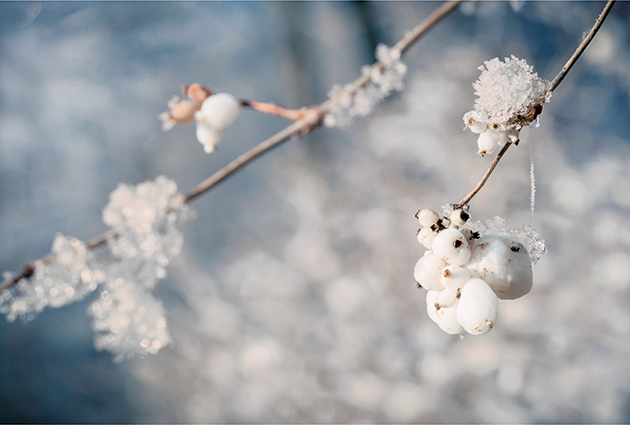The beautiful snowberry
Steven Desmond tales a closer look at the snowberry, an elegant deciduous shrub


The snowberry is one of the more durable features of the park landscape in this country. Many times over the years, I’ve found myself poking about in some distant corner of a relict landscape garden, generally on a cold February morning when such places can be ‘read’ with a knowing eye. There are usually plenty of big old trees surviving from the original layout, but very little of the shrubby understorey has made it through the long years of neglect.
One sure friend in these circumstances, however, is the snowberry, quite undisturbed where all around it had succumbed to a lack of attention years before. It has, on more than one occasion, been virtually the only evidence on the ground of the location of an ancestral shrubbery, patiently awaiting the arrival of Prince Charming, only to be confronted with me.
This durability is one of the many reassuring features of the snowberry. It quietly carries on with its business and is unconcerned whether the ground around it is neatly hoed or left to its own devices. It grows in dry ground, wet ground, stony ground, open sunshine or deep shade with equanimity. Its thin-textured, curiously papery leaves are either rounded ovals or a little lobed at the base and grow in opposite pairs on stiffly twiggy shoots that rise to chest height. They fall in the winter.
The inconspicuous bell-shaped flowers, white with a tinge of pink, like a poor man’s raspberry ripple, are borne in little groups over the summer months and gradually metamorphose, mainly through the good offices of moths, into the fruits that give the plant its common name.
These fruits are the very thing that catch the eye of walkers, like myself, in old parkland. They’re formed into clusters of white marbles at the shoot tips, visible from a long way off. Their persistence through the winter is something of a wonder, but all this really tells us is that no creature is particularly interested in eating them. In a hard winter, they will eventually go, taken by the pheasants for which the bush is often used as game cover, but this reluctance suggests they’re the last resort of the very hungry. It also suggests to the onlooker that the snowberry isn’t a native of this country.
Our shrub, in fact, comes from the USA, especially in the woods of the north-west, where it spreads over into Canada. Even there, it took a long time for settlers of European extraction to pay any attention to it, until it finally made it into the botanists’ notebooks at the beginning of the 19th century. During the surveying expedition led by Lewis and Clark to map and claim the vast territory of the Louisiana Purchase, Capt Meriwether Lewis managed, among all his other tasks, to record and describe our bush.
He supplied a specimen to no less a figure than Thomas Jefferson, who, forwarding a rooted sucker to a friend, described it thus: ‘A very handsome little shrub of the size of a currant bush. Its beauty consists in a great production of berries through the winter, after the leaves have fallen… we call it the snowberry bush.’
Exquisite houses, the beauty of Nature, and how to get the most from your life, straight to your inbox.
After one or two tentative name changes, it eventually settled into the genus Symphoricarpos. The first specimens seem to have arrived in Britain in 1817. The method of propagation remains unchanged.
There are now several species of Symphoricarpos known to science. They’re rather closely related, so that authorities differ from time to time as to which one is which, but our main fellow under discussion here is S. albus. The world has broadly been content to translate the common name of snowberry into its many languages, but one or two variants have surfaced here and there.
The waxberry is certainly descriptive, but the corpseberry conveys an unreasonably deathly connotation, although eating the berries will, I believe, make you feel extremely uncomfortable before the stomach pump is introduced. Some Americans call it the altogether more cheerful-sounding ice apple. I hope their children don’t get the wrong idea. In a similar vein, some folk in the West Country call it ‘lardy balls’ in a pleasantly impertinent manner. If you know of other terms, we await your correspondence.
For those bored with white, there is always another species, Symphoricarpos orbiculatus, commonly known as the coralberry for its pink fruits. Then again, a century ago, an enterprising French nurseryman crossed two species to create the lumberingly named Symphoricarpos x chenaultii, with small, purplish-red berries to add variety to the garden scene.
The purist will, however, continue to rely on the candid virtues of the snowberry. Its sterling reliability, non-intrusive nature (at least, over here) and, above all, its apparently limitless lifespan will always attract a smile and a nod from the winter gardener.
Country Life is unlike any other magazine: the only glossy weekly on the newsstand and the only magazine that has been guest-edited by His Majesty The King not once, but twice. It is a celebration of modern rural life and all its diverse joys and pleasures — that was first published in Queen Victoria's Diamond Jubilee year. Our eclectic mixture of witty and informative content — from the most up-to-date property news and commentary and a coveted glimpse inside some of the UK's best houses and gardens, to gardening, the arts and interior design, written by experts in their field — still cannot be found in print or online, anywhere else.
